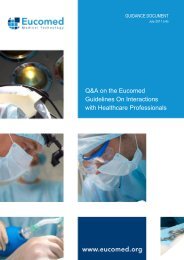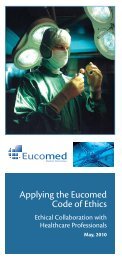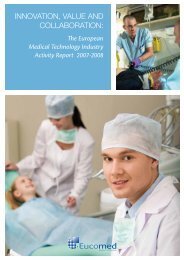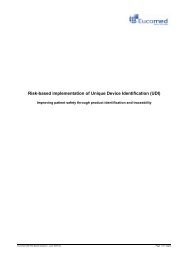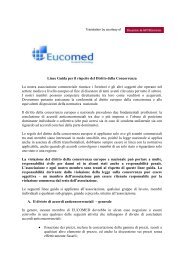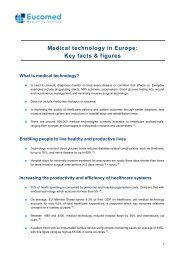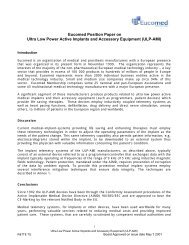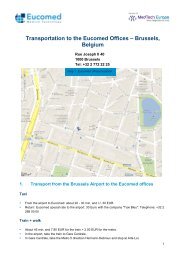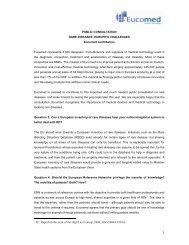Eucomed Position paper: Natural rubber latex gloves and latex allergy
Eucomed Position paper: Natural rubber latex gloves and latex allergy
Eucomed Position paper: Natural rubber latex gloves and latex allergy
You also want an ePaper? Increase the reach of your titles
YUMPU automatically turns print PDFs into web optimized ePapers that Google loves.
EUCOMED <strong>Position</strong> Paper<br />
<strong>Natural</strong> Rubber Latex Gloves <strong>and</strong> Latex Allergy<br />
This position <strong>paper</strong> has been prepared by the EUCOMED Latex Task Group upon<br />
which are represented many of the most important suppliers of <strong>Natural</strong> Rubber Latex<br />
(NRL) <strong>and</strong> synthetic <strong>gloves</strong> in Europe <strong>and</strong> worldwide.<br />
EUCOMED is the major European medical technology industry association with a<br />
membership comprising companies with European operations together with national<br />
<strong>and</strong> pan-European organizations in the medical technology sectors.<br />
Currently, EUCOMED represents more than 2,500 companies employing<br />
approximately 300,000 EU citizens that provide tens of thous<strong>and</strong>s of different types<br />
of healthcare products within the EU <strong>and</strong> globally.<br />
EXECUTIVE SUMMARY<br />
Over the past few years, EUCOMED <strong>and</strong> its members have been closely involved in<br />
discussions concerning natural <strong>rubber</strong> <strong>allergy</strong>. In 1998-1999, EUCOMED participated in<br />
an Ad Hoc Working Group charged by the European Commission with examination of<br />
the issue. In response to a series of questions formulated by this group, the Scientific<br />
Committee on Medicinal Products <strong>and</strong> Medical Devices (SCMPMD) recently adopted its<br />
opinion on natural <strong>rubber</strong> <strong>latex</strong> <strong>allergy</strong>. The SCMPMD opinion identified a number of<br />
areas for further study as well as certain practical steps that could be considered to<br />
minimize risk.<br />
EUCOMED believes that it is now appropriate to consider follow-up actions based on<br />
the work of the SCMPMD. The European harmonized st<strong>and</strong>ard EN 455-3 has already<br />
been agreed <strong>and</strong> published to address the biocompatibility of NRL medical <strong>gloves</strong>.<br />
However, further recommendations for NRL <strong>gloves</strong> should be considered at the<br />
European level, to avoid unilateral action by Member States that could fragment the<br />
internal market. This <strong>paper</strong> explores the options for a way forward based on the current<br />
state of the science reflected in the opinion of the SCMPMD. In particular, EUCOMED<br />
believes that the Commission <strong>and</strong> the Member States could consider the following<br />
further recommendations for NRL <strong>gloves</strong>:<br />
• Recommended limits on water-extractable proteins for NRL medical <strong>gloves</strong> of 200<br />
micrograms/dm²<br />
EUCOMED <strong>Position</strong> Paper – <strong>Natural</strong> Rubber Latex Gloves <strong>and</strong> Latex Allergy<br />
EUCOMED Latex Task Group – May 14 th 2001
FINAL<br />
• Recommended limits on glove powder of 30 milligrams/dm² for powdered NRL<br />
medical <strong>gloves</strong>, along with a definition of powder-free <strong>gloves</strong> limiting residual powder<br />
to 2 milligrams, regardless of glove size;<br />
• Specification of either the modified Lowry assay or amino acid analysis as<br />
appropriate testing methods, with further support for development of an appropriate<br />
allergen assay; <strong>and</strong><br />
• A labeling requirement.<br />
EUCOMED hopes that the proposals contained in this <strong>paper</strong> will contribute to the<br />
formulation <strong>and</strong> establishment of an achievable <strong>and</strong> uniform set of recommendations<br />
throughout Europe, taking into account the critical role NRL <strong>gloves</strong> play in the<br />
healthcare setting <strong>and</strong> the state of the art in glove manufacturing.<br />
DISCUSSION<br />
Regulation of NRL <strong>gloves</strong> to date<br />
NRL <strong>gloves</strong> are medical devices regulated by Directive 93/42/EEC, as amended (the<br />
Medical Devices Directive or MDD). The MDD is a New Approach directive that is<br />
confined to defining the essential requirements that medical devices must meet.<br />
Manufacturers of medical devices may demonstrate conformity with the essential<br />
requirements by complying with voluntary harmonized European st<strong>and</strong>ards. A number<br />
of st<strong>and</strong>ards pertain to NRL medical <strong>gloves</strong>, in particular the harmonized European<br />
st<strong>and</strong>ard EN 455-3 on the biocompatibility of NRL medical <strong>gloves</strong> (EN 455 “Medical<br />
<strong>gloves</strong> for single use - Part 3: Requirements <strong>and</strong> testing for biological evaluation,”<br />
published 14 October 2000, O.J. No. C 293/9).<br />
NRL <strong>gloves</strong> play a key role in barrier protection, both in the operating room <strong>and</strong> the<br />
patient care setting. NRL glove use has increased dramatically since the mid-1980s as<br />
a result of the universal precautionary principle, implemented to prevent the spread of<br />
HIV. NRL <strong>gloves</strong> also protect healthcare workers <strong>and</strong> patients against other bloodborne<br />
pathogens such as Hepatitis B <strong>and</strong> C.<br />
In addition to irritant dermatitis reported by healthcare workers who wear <strong>gloves</strong>, allergic<br />
reactions to NRL proteins <strong>and</strong> to the chemical constituents used in the manufacturing<br />
process of NRL have been reported. These concerns prompted the Commission to<br />
examine further the issues surrounding <strong>latex</strong> <strong>allergy</strong>.<br />
The Commission has funded a study on the measurement <strong>and</strong> testing of allergologically<br />
relevant compounds in disposable <strong>gloves</strong>. The study aimed to evaluate the significance<br />
of the various testing methods used with regard to determining the allergenicity of NRL<br />
<strong>gloves</strong>. 1 In 1998, the Commission’s DG Enterprise set up the Ad Hoc Working Group on<br />
Medical Devices manufactured of <strong>Natural</strong> Rubber Latex (Ad Hoc Group). The Ad Hoc<br />
1<br />
European Commission. Determination of allergological relevant compounds in disposable <strong>gloves</strong>.<br />
Correlation of chemical, allergological <strong>and</strong> immunological data. Final report MAT1 - CT 940060. European<br />
Commission, Directorate General XII Science, Research <strong>and</strong> Development. Brussels, Belgium 1998.<br />
- 2 -
FINAL<br />
Group surveyed the issues raised by NRL <strong>gloves</strong> 2 in order to develop a series of<br />
questions for the SCMPMD. The Ad Hoc Group referred these questions to the<br />
SCMPMD in April 1999.<br />
Opinion of the Scientific Committee<br />
The SCMPMD adopted its opinion on natural <strong>rubber</strong> <strong>latex</strong> <strong>allergy</strong> on 27 June 2000. The<br />
opinion was posted on the Internet at the end of July 2000. The following is a brief<br />
summary of several of the key findings.<br />
Leachable protein levels. The SCMPMD reports that a relationship between leachable<br />
protein levels in NRL <strong>and</strong> the risk of allergic reaction or sensitization has been<br />
demonstrated in several studies, either directly or indirectly. The SCMPMD thus<br />
suggests that this risk can be reduced by minimizing the level of leachable proteins.<br />
Using this approach relies on protein levels as a proxy for allergen levels in NRL<br />
medical <strong>gloves</strong>. The SCMPMD notes that “at the moment measurement of total protein<br />
is the best available way to monitor the allergenic properties of <strong>latex</strong> products, but it may<br />
not be sufficient” because the “total protein content is not necessarily equivalent to<br />
allergen content.” The SCMPMD also points out that “at present, there is no method<br />
routinely available that can reliably evaluate the allergen content of NRL products.”<br />
Glove powder. The SCMPMD’s opinion states that “it has not been demonstrated that<br />
powdered <strong>gloves</strong> are more likely to induce sensitization than powder-free <strong>gloves</strong>,<br />
provided the protein content of the <strong>gloves</strong> is identical.” The SCMPMD’s opinion further<br />
states that “the glove powder acts as a protein carrier resulting in airborne allergens.”<br />
However, the SCMPMD also notes that “the reaction to glove powder is not dependent<br />
on the powder but on the proteins carried by the powder.”<br />
The case for developing further product recommendations for NRL <strong>gloves</strong><br />
EUCOMED welcomes the SCMPMD’s opinion concerning the science of <strong>rubber</strong> <strong>allergy</strong>.<br />
As such, the opinion forms a reference point for scientific discussions at the European<br />
level <strong>and</strong> can provide the basis for any recommendations governing NRL products.<br />
EUCOMED believes that the Commission <strong>and</strong> the Member States should now consider<br />
appropriate recommendations that respond to the findings of the SCMPMD. In past<br />
comments, EUCOMED has indicated its willingness to work with the regulatory<br />
authorities to this end. EUCOMED believes that any additional product<br />
recommendations established in response to the SCMPMD’s findings should be<br />
informed both by the current state of knowledge on <strong>latex</strong> <strong>allergy</strong> issues as well as the<br />
continual progress made in glove manufacturing.<br />
This is consistent with the risk/benefit analysis required by the Medical Devices<br />
Directive. The first essential requirement of the directive is that “devices must be<br />
designed <strong>and</strong> manufactured in such a way that they will not compromise the safety <strong>and</strong><br />
health of patients <strong>and</strong> users . . . provided that any risks which may be associated with<br />
their use constitute acceptable risks when weighed against the benefits . . . .” Given this<br />
2<br />
EUCOMED took an active role in this process, including the submission of detailed industry<br />
comments.<br />
- 3 -
FINAL<br />
clear principle, any regulation of NRL medical <strong>gloves</strong> must balance the potential risk of<br />
allergic reaction against the unique <strong>and</strong> primary role played by NRL <strong>gloves</strong> in controlling<br />
the spread of infectious disease. Such regulation should take account of the following<br />
key factors:<br />
• Access <strong>and</strong> affordability -- Billions of pairs of NRL <strong>gloves</strong> are required every<br />
year in the healthcare setting. The ready availability of cost-effective NRL<br />
<strong>gloves</strong> must be guaranteed, notably for national healthcare reimbursement<br />
systems.<br />
• Safety -- NRL <strong>gloves</strong> are crucial to healthcare workers <strong>and</strong> patients in the<br />
fight against deadly blood-borne pathogens, such as HIV, as well as Hepatitis<br />
B <strong>and</strong> C.<br />
• Manufacturing technology issues -- NRL proteins cannot be completely<br />
eliminated from finished NRL products. Powder is also used in the<br />
manufacturing process of nearly all NRL <strong>gloves</strong>. Overly restrictive protein<br />
<strong>and</strong> powder level limits may compromise barrier qualities <strong>and</strong> increase cost.<br />
• Low prevalence of allergic reactions -- Allergies to NRL proteins are rare.<br />
Most people who are sensitized to NRL never develop an allergic reaction,<br />
<strong>and</strong> the great majority of allergic reactions are mild. The most common<br />
reactions to NRL are irritant rather than allergic responses.<br />
• The ubiquity of NRL in medical devices <strong>and</strong> consumer products -- NRL<br />
<strong>gloves</strong> are not the sole source of exposure to NRL. Hundreds of medical<br />
devices contain NRL, including catheters, b<strong>and</strong>ages, syringes, <strong>and</strong><br />
anesthesia masks. Thous<strong>and</strong>s of consumer products also contain NRL, such<br />
as condoms, balloons, <strong>rubber</strong> b<strong>and</strong>s, athletic shoes, carpeting, <strong>and</strong> tires.<br />
Regulating the use of NRL <strong>gloves</strong> will not resolve <strong>latex</strong> <strong>allergy</strong> issues.<br />
EUCOMED wishes to emphasize the need for a uniform approach at the EU level in line<br />
with the approach adopted by the Medical Devices Directive. Member States should<br />
not take unilateral measures grounded in individual, <strong>and</strong> perhaps outdated assessments<br />
of the risks posed by NRL <strong>gloves</strong>. Such measures threaten the single market in medical<br />
devices, which the Medical Devices Directive is intended to achieve.<br />
Last, it should be noted that the major suppliers of NRL <strong>gloves</strong> produce for the world<br />
market. For years, many responsible manufacturers of NRL medical <strong>gloves</strong> have<br />
attempted to lower total protein <strong>and</strong> powder levels in their NRL <strong>gloves</strong>. It is in the<br />
interest of all to harmonize regulatory approaches related to these efforts while holding<br />
costs to a minimum. EUCOMED believes that the European Union should focus on an<br />
approach that could provide the basis for global harmonization, while at the same time<br />
satisfying the requirements of the MDD.<br />
Possible ways forward<br />
EUCOMED believes that the Commission <strong>and</strong> the Member States should consider the<br />
following:<br />
- 4 -
FINAL<br />
• Achievable limits on water-extractable protein levels <strong>and</strong> powder<br />
Protein. A practical approach in the current state of science could be to<br />
recommend reasonable limits on the amount of water-extractable protein for NRL<br />
medical <strong>gloves</strong> (see Opinion of the SCMPMD on natural <strong>rubber</strong> <strong>latex</strong> <strong>allergy</strong><br />
adopted on 27 June 2000, Doc. SANCO/SCMPMD/2000/0009 Final, p. 2 <strong>and</strong> p.<br />
9).<br />
NRL glove manufacturers have already considerably reduced the level of<br />
extractable proteins in their products. Any limit that would be set would have to<br />
take into account existing glove manufacturing technology. In particular, the<br />
significant lot-to-lot variations that inevitably exist in manufacturing, <strong>and</strong> the<br />
limitations <strong>and</strong> interlaboratory variations of the assays used to measure protein<br />
levels must be considered. In view of these issues, the across-the-board level of<br />
30 micrograms/g that has sometimes been advocated would not be workable. A<br />
more realistic limit value would be on the order of 200 micrograms/dm². 3<br />
In this respect, EUCOMED notes that the Medical Devices Directive itself<br />
provides that the essential requirements must be interpreted <strong>and</strong> applied in such<br />
a way as to take account of technology <strong>and</strong> practice existing at the time of<br />
design <strong>and</strong> of technical <strong>and</strong> economic considerations that are compatible with a<br />
high level of protection of health <strong>and</strong> safety.<br />
Powder. As noted above, the SCMPMD report observed that it has not been<br />
demonstrated that powdered <strong>gloves</strong> are more likely to induce sensitization than<br />
non-powdered <strong>gloves</strong>, assuming equal levels of protein. Since EUCOMED<br />
strongly supports a uniform approach to regulation of NRL <strong>gloves</strong>, it believes that<br />
workable recommended limits on powder could nevertheless be considered to<br />
discourage unilateral measures at national level. EUCOMED would also<br />
propose a uniform st<strong>and</strong>ard for what constitutes a powder-free glove. Relevant<br />
limits could be as follows: 4<br />
• Powdered NRL medical <strong>gloves</strong> would be limited to no more than 30<br />
milligrams of powder per dm²; <strong>and</strong><br />
• Trace or residual powder in powder-free <strong>gloves</strong> would be limited to no more<br />
than 2 milligrams particulate weight per glove, regardless of glove size.<br />
• Testing methods<br />
The testing method applied to NRL <strong>gloves</strong> is of overarching importance. This is<br />
confirmed by the fact that the European Commission commissioned a study on<br />
3<br />
For medical devices such as <strong>gloves</strong>, which are in temporary contact with the skin, EUCOMED believes that<br />
recommended limits are more appropriately expressed in terms of unit of surface area (dm 2 ) than unit of weight<br />
(g)(in contrast to implantable medical devices). This is consistent with the approach developed by the American<br />
Society for Testing <strong>and</strong> Materials (ASTM). A limit of 200 micrograms/dm 2 is in fact roughly equivalent to 200<br />
micrograms/g. This figure takes account of variations in the characteristics of <strong>rubber</strong> (a natural product), in<br />
production processes, <strong>and</strong> in the test methods used to measure total protein levels.<br />
4<br />
These levels are consistent with the initial st<strong>and</strong>ard being formulated by ASTM.<br />
- 5 -
FINAL<br />
this specific issue in 1998. Any limits imposed must be based on a reliable<br />
assay capable of generating reproducible results.<br />
Two methods are used to measure protein -- the modified Lowry method <strong>and</strong><br />
amino acid analysis. 5 Both methods measure the total amount of protein, <strong>and</strong><br />
not just allergenic protein. The modified Lowry method is relatively simple to<br />
use. However, the modified Lowry assay has a relatively high quantification limit.<br />
In addition, certain chemicals, including those used in the manufacture of NRL<br />
products, can interfere with the results of the assay. As a result, the modified<br />
Lowry method is viewed with skepticism by a significant segment of industry.<br />
Both the 1998 Commission-funded study <strong>and</strong> the SCMPMD opinion find that<br />
amino acid analysis (e.g., by HPLC) is a sensitive <strong>and</strong> specific method for<br />
determining protein content. Amino acid analysis should be accepted as an<br />
alternative to the modified Lowry method. In addition, consideration could be<br />
given to an approach suggested in the opinion of the SCMPMD. Amino acid<br />
analysis could be used as a reference method to determine total protein levels in<br />
finished products during process validation. The modified Lowry method,<br />
calibrated by amino acid analysis, might then be useful as a low-cost st<strong>and</strong>ard<br />
method of manufacturing process control.<br />
In any event, EUCOMED strongly believes that future action should address the<br />
need, identified by the SCMPMD, for the availability of allergenic protein assays,<br />
e.g., validated, commercially available competitive IgE inhibition assays such as<br />
DPC AlaSTAT, Upjohn-Pharmacia <strong>and</strong> RAST-type tests. Unlike assays that<br />
measure total leachable proteins, assays measuring allergens come closer to<br />
measuring what matters -- clinically relevant allergens, not all proteins. As<br />
needed, the Commission should support further work to st<strong>and</strong>ardize <strong>and</strong><br />
promote the availability of such assays.<br />
• Labeling requirements<br />
EUCOMED submits that labeling is a central part of the way forward, in particular<br />
in light of the overall low level of risk posed by natural <strong>rubber</strong> <strong>allergy</strong> when<br />
weighed against the benefits provided by <strong>latex</strong> <strong>gloves</strong> (low prevalence of <strong>latex</strong><br />
<strong>allergy</strong> in population at large; unique barrier protection function of NRL medical<br />
<strong>gloves</strong>; extremely rare incidence of life-threatening allergic reaction to NRL).<br />
Clear labeling requirements would provide a means of alerting allergic individuals<br />
to the risk of an allergic reaction, without compromising the need for affordable<br />
<strong>and</strong> effective barrier protection, in accordance with the MDD’s Essential<br />
Requirement 13(3)(k).<br />
EUCOMED <strong>and</strong> its members welcome the opportunity to provide ongoing support to the<br />
Commission <strong>and</strong> national regulatory authorities in developing appropriate<br />
recommendations for NRL <strong>gloves</strong>.<br />
* * *<br />
5<br />
Powder testing methods are already st<strong>and</strong>ardized <strong>and</strong> do not present an issue.<br />
- 6 -
FINAL<br />
For further information on this <strong>Position</strong> Paper or questions please contact:<br />
EUCOMED<br />
Tel: +32 2 772 22 12<br />
Fax: +32 2 771 39 09<br />
Email: eucomed@eucomed.be<br />
- 7 -



